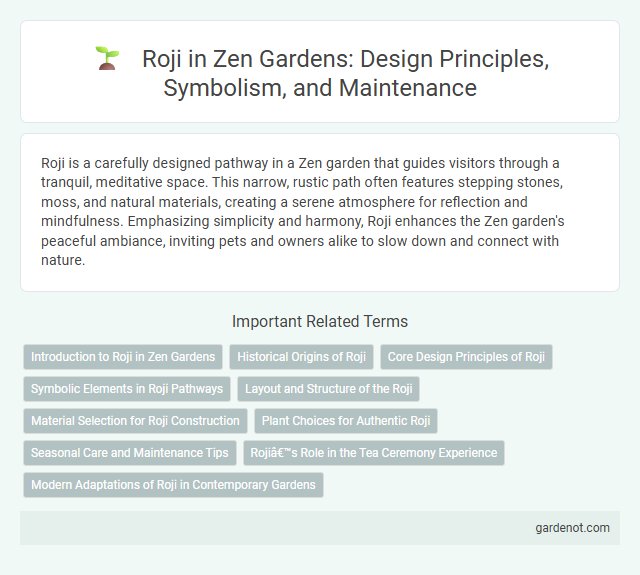Roji is a carefully designed pathway in a Zen garden that guides visitors through a tranquil, meditative space. This narrow, rustic path often features stepping stones, moss, and natural materials, creating a serene atmosphere for reflection and mindfulness. Emphasizing simplicity and harmony, Roji enhances the Zen garden's peaceful ambiance, inviting pets and owners alike to slow down and connect with nature.
Introduction to Roji in Zen Gardens
Roji is a traditional Japanese garden path leading to a tea house, designed to create a serene atmosphere for tea ceremonies. This carefully arranged space emphasizes simplicity, natural materials, and subtle transitions between elements, enhancing mindfulness and tranquility. Roji serves as a symbolic journey that prepares guests both mentally and spiritually before entering the tea room.
Historical Origins of Roji
Roji, the traditional Japanese tea garden, traces its historical origins to the 15th century during the Muromachi period, designed to create a tranquil pathway leading to the tea house for Chanoyu (tea ceremony). Influenced by Zen Buddhism and tea master Sen no Rikyu, Roji embodies simplicity, natural beauty, and mindfulness, shaping the aesthetic and spiritual principles of Japanese garden design. Its layout typically features moss, stepping stones, and water basins, symbolizing purification and reflecting Zen concepts of harmony and impermanence.
Core Design Principles of Roji
Roji embodies the core design principles of simplicity, naturalness, and tranquility, essential to creating a meditative Zen garden space. Its layout emphasizes asymmetry, minimalism, and the harmonious use of natural materials like moss, stone, and gravel to evoke a sense of peaceful transition. The meticulous arrangement aims to foster mindfulness and a deep connection with nature while guiding visitors from the mundane world to a serene inner sanctuary.
Symbolic Elements in Roji Pathways
Roji pathways in Zen gardens incorporate symbolic elements such as stepping stones, moss, and lanterns, each embodying spiritual transition and mindfulness. Stepping stones guide the visitor on a deliberate journey, representing the path to enlightenment, while moss symbolizes simplicity and natural beauty. Lanterns provide subtle illumination, reflecting the light of wisdom amidst tranquility.
Layout and Structure of the Roji
The Roji is a carefully designed, narrow pathway marked by stepping stones, moss, and lanterns leading to a tea house, emphasizing simplicity and tranquility. Its layout prioritizes natural elements arranged asymmetrically to evoke a sense of natural beauty and spiritual cleansing. The structure often includes a waiting bench and a tsukubai basin for purifying hands, enhancing the meditative experience before the tea ceremony.
Material Selection for Roji Construction
Material selection for Roji construction centers on natural and locally sourced elements like unpolished stone, weathered wood, and rough gravel to evoke simplicity and wabi-sabi aesthetics. Bamboo fences and stepping stones made of granite or sandstone provide both functionality and a rustic texture unique to traditional Japanese Zen gardens. The choice of materials not only enhances the sensory experience but also harmonizes the Roji with its surrounding environment, fostering tranquility and contemplation.
Plant Choices for Authentic Roji
Plant choices for an authentic Roji emphasize simplicity and seasonal changes, featuring evergreen moss, azaleas, and Japanese maples to create a serene, contemplative atmosphere. Low-growing ground covers like hosta and ferns complement the winding stone path, enhancing the garden's minimalistic aesthetic and tranquility. Bamboo and camellias are often included to maintain traditional Japanese garden symbolism and provide subtle texture contrasts.
Seasonal Care and Maintenance Tips
Roji pathways in a Zen garden require seasonal care to preserve their aesthetic and functionality, including clearing fallen leaves and debris in autumn to prevent mold and slippery surfaces. During spring and summer, regular pruning of surrounding moss and plants enhances the tranquil atmosphere while controlling overgrowth. Winter maintenance involves checking for ice buildup and ensuring gravel patterns remain intact despite weather conditions.
Roji’s Role in the Tea Ceremony Experience
Roji serves as a transitional pathway in the tea ceremony, symbolizing a journey from the outer world to a serene inner space. This carefully designed garden emphasizes simplicity and natural beauty, encouraging mindfulness and reflection before entering the tearoom. The roji's moss, stepping stones, and minimalistic elements create an atmosphere of tranquility essential for the spiritual preparation integral to the tea ceremony.
Modern Adaptations of Roji in Contemporary Gardens
Modern adaptations of Roji in contemporary gardens integrate traditional Japanese aesthetics with minimalist design principles, emphasizing simplicity, natural materials, and asymmetry. These gardens often incorporate sustainable elements such as native plants, stone pathways, and water features that evoke tranquility and mindfulness. Designers blend cultural symbolism with modern landscaping technology to create serene spaces ideal for meditation and reflection.
Roji Infographic

 gardenot.com
gardenot.com